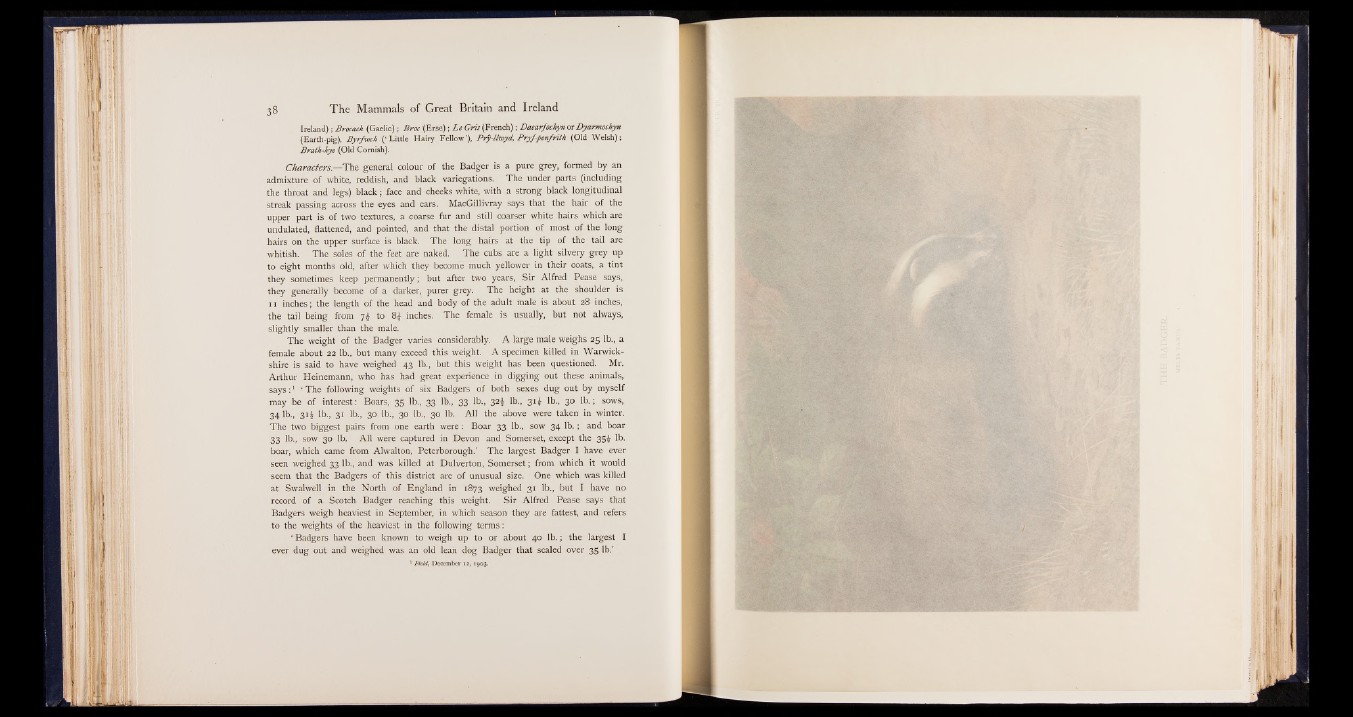
Ireland) ; Brocack (Gaelic) ; Broc "(Erse) ; Le Gris (French) ; Daearfochyn or Dyarmochyn
(Earth-pig), Byrfwch (‘ Little Hairy Fellow ’), Pry-llwyd, Pryf-penfrith (Old Welsh);
Brath-kye (Old Cornish).
Characters—The general colour of the Badger is a pure grey, formed by an
admixture of white, reddish, and black variegations. The under parts (including
the throat and legs) black: face and cheeks white, with a strong black longitudinal
streak passing across the eyes and ears. MacGillivray says that the hair of the
upper part is of two textures, a coarse fur and still coarser white hairs which are
undulated, flattened, and pointed, and that the distal portion of most of the long
hairs on the upper surface is black. The long hairs at the tip of the tail are
whitish. The soles of the feet are naked. The cubs are a light silvery grey up
to eight months old, after which they become much yellower in their coats, a tint
they sometimes keep permanently; but after two years, Sir Alfred Pease says,
they generally become of a darker, purer grey. The height at the shoulder is
11 inches; the length of the head and body of the adult male is about 28 inches,
the tail being from 7^ to 8£ inches. The female is usually, but not always,
slightly smaller than the male.
The weight of the Badger varies considerably. A large male weighs 25 lb., a
female about 22 lb., but many exceed this weight. A specimen killed in Warwickshire
is said to have weighed 43 lb., but this weight has been questioned. Mr.
Arthur Heinemann, who has had great experience in digging out these animals,
say s : 1 ‘ The following weights of six Badgers of both sexes dug out by myself
may be of interest: Boars, 35 lb., 33 lb., 33 lb., 32^ lb., 3 1 £ lb., 30 lb .; sows,
34 lb., 31^ lb., 3 1 lb., 30 lb., 30 lb., 30 lb. All the above were taken in winter.
The two biggest pairs from one earth were: Boar 33 lb., sow 34 lb .; and boar
33 lb., sow 30 lb. All were captured in Devon and Somerset, except the 35^ lb.
boar, which came from Alwalton, Peterborough.’ The largest Badger I have ever
seen weighed 33 lb., and was killed at Dulverton, Somerset; from which it would
seem that the Badgers of this district are of unusual size. One which was killed
at Swalwell in the North of England in 1873 weighed 3 1 lb., but I have no
record of a Scotch Badger reaching this weight. Sir Alfred Pease says that
Badgers weigh heaviest in September, in which season they are fattest, and refers
to the weights of the heaviest in the following terms:
‘ Badgers have been known to weigh up to or about 40 lb .; the largest I
ever dug out and weighed was an old lean dog Badger that scaled over 35 lb.’
1 Field, December 12, 1903.